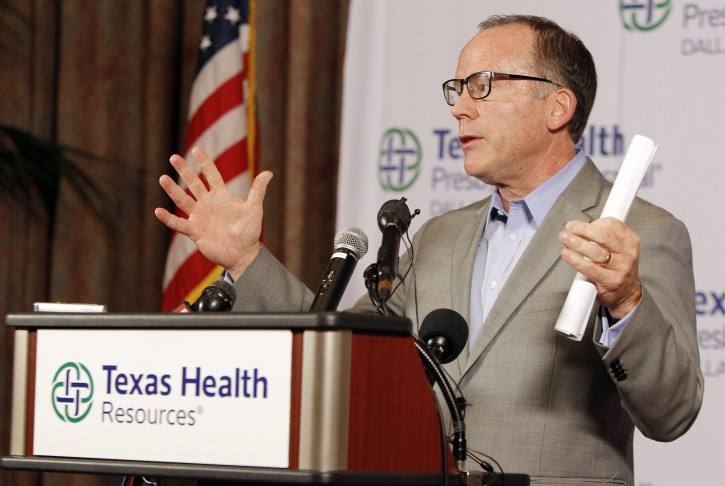 Dallas, TX – How did it happen?
Dallas, TX – How did it happen?
Subscribe to our Daily Roundup Email
That’s the big question as federal health officials investigate the case of a Dallas health worker who treated an Ebola patient and ended up with the disease herself.
These are professionals and this is the United States, where the best conditions and protective gear are available, unlike in West Africa, where the Ebola epidemic is raging in much poorer conditions.
The health worker wore protective gear while having extensive contact with Thomas Eric Duncan, the Liberian man who died Wednesday of Ebola at Texas Health Presbyterian Hospital.
Officials say she has not been able to pinpoint any breach in infection control protocols, although there apparently was a breach, they say.
Experience shows that health workers can safely care for Ebola patients, “but we also know that it’s hard and that even a single breach can result in contamination,” Dr. Thomas Frieden, director of the Centers for Disease Control and Prevention, said Sunday on CBS’ “Face the Nation.”
The situation also raises fresh concerns about whether any U.S. hospital can safely handle Ebola patients, as health officials have insisted is possible.
Some questions and answers about the new case.
Q: What protection do health workers have?
A: The exact gear can vary. A hazardous material type suit usually includes a gown, two sets of gloves, a face mask, and an eye shield. There are strict protocols for how to use it correctly.
“When you put on your garb and you take off your garb, it’s a buddy system,” with another health worker watching to make sure it’s done right, said Dr. Dennis Maki, University of Wisconsin-Madison infectious disease specialist and former head of hospital infection control.
Q: How might infection have occurred?
A: Officials are focusing on two areas: How the garb was removed, and the intensive medical procedures Duncan received, which included kidney dialysis and a breathing machine. Both involve inserting tubes — into blood vessels or an airway. That raises the risk a health worker will have contact with the patient’s bodily fluids, which is how Ebola spreads.
“Removing the equipment can really be the highest risk. You have to be extremely careful and have somebody watching you to make sure you remember all the steps,” said Dr. Eileen Farnon, a Temple University doctor who formerly worked at the CDC and led teams investigating past Ebola outbreaks in Africa.
“After every step you usually would do hand hygiene,” washing your hands with antiseptic or being sprayed with a chlorine spray, she said.
Q: How else could infection have happened?
A: Some of the garb the health worker takes off might brush against a surface and contaminate it. New data suggest that even tiny droplets of a patient’s body fluids can contain the virus, Maki said.
“I can have on the suit and be very careful, but I can pick up some secretions or body fluids on a surface” and spread it that way, he said.
Q: Can any U.S. hospital safely treat Ebola patients?
A: Frieden and other health officials say yes, but others say the new case shows the risks.
“We can’t control where the Ebola patient appears,” so every hospital’s emergency room needs to be prepared to isolate and take infection control precautions, Maki said.
That said, “I don’t think we should expect that small hospitals take care of Ebola patients. The challenge is formidable,” and only large hospitals like those affiliated with major universities truly have enough equipment and manpower to do it right, Maki said.
“If we allow it to be taken care of in hospitals that have less than optimal resources, we will promote the spread,” he warned.
The case heightens concern for health workers’ safety, and nurses at many hospitals “are alarmed at the inadequate preparation they see,” says a statement from Rose Ann DeMoro, executive director of the union, National Nurses United.
Q: Should Ebola patients be transferred to one of the specialized centers that have treated others in the U.S.?
A: Specialized units are the ideal, but there are fewer than half a dozen in the nation and they don’t have unlimited beds. “It is also a high-risk activity to transfer patients,” potentially exposing more people to the virus, Farnon said.
Q. What is CDC recommending the hospital do?
A. Training has been ramped up, and the CDC now recommends the hospital minimize the number of people caring for an Ebola patient, perform only procedures essential to support the patient’s care, and name a fulltime infection control supervisor while any Ebola patient is being cared for. Frieden also said the agency was taking a new look at personal protective equipment, “understanding that there is a balance and putting more on isn’t always safer — it may make it harder to provide effective care.”
___
Online:
CDC Ebola advice: http://tinyurl.com/nxghaf9
Protective equipment: http://tinyurl.com/qdpk8ak

President Obola refuses to acknowledge that it might be inevitable to pass on the virus. Perhaps it is airborne.
The “Protective”uniform described here are called “Universal precautions”among healthcare professionals.The use of this type of protection is laughable when dealing with a highly contagious virus like Ebola.The CDC uses what could best be described as a “Space suit” when studying the Ebola virus in a lab.The use of this suit insures you don’t have the kind of infections they have at this hospital.
There are procedures of how to put on the protective garments and there are procedures on how to take them off, and if the person is in a hurry and does not follow the entire procedure accidents do happen. A person must follow procedures to the letter or contamination can occur.